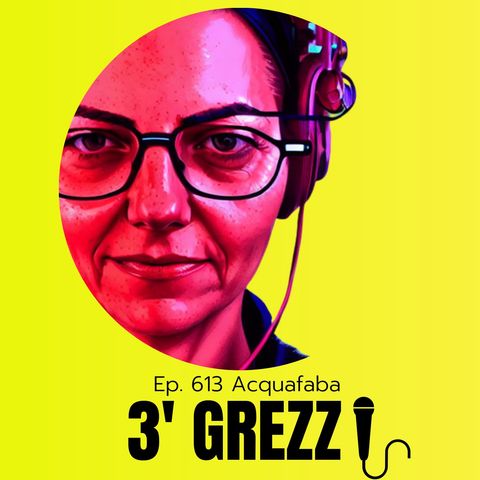3' grezzi Ep. 613 Acquafaba

Download and listen anywhere
Download your favorite episodes and enjoy them, wherever you are! Sign up or log in now to access offline listening.
3' grezzi Ep. 613 Acquafaba
Description
Grazie a te, tenore francese che hai scoperto l'acquafaba! Corro a sperimentare, e fatemi sapere se sperimentate anche voi! TRASCRIZIONE [Eng translation below] Amiche e amici ho fatto una scoperta...
show moreTRASCRIZIONE [Eng translation below]
Amiche e amici ho fatto una scoperta fantastica. Allora, cominciamo col dire che a me piacciono molto i legumi, soprattutto i ceci, anche perché per più di vent'anni sono stata vegetariana, per cui non mangiavo carne e i legumi facevano parte integrante della mia dieta. Però fino a ieri, quando mi capitava di acquistare ceci, o più in generale legumi in scatola, aprivo la scatola e la prima cosa che facevo era lavare i legumi perché pensavo che l'acqua dentro il barattolo fosse una cosa negativa, piena di conservanti e di boh, schifezze varie. E invece ieri ho scoperto l'acquafaba. Cos'è l'acquafaba? È il liquido che viene messo dentro i ceci e dentro i fagioli cannellini per conservarli, oppure se comprate ceci e fagioli secchi e li mettete a bagno, io cerco di farlo, vorrei farlo più spesso, ma richiede una preparazione e una programmazione, soprattutto devi pensarci la notte, poi mettere a bollire per per secoli, quindi compro in scatola. Però se siete brave e bravi e mettete le cose a bagno, anche quell'acqua va bene.
Quest'acqua si chiama acquafaba, i due nomi, di acqua di fagioli vengono dal latino, ed è una cosa abbastanza recente. È stata individuata negli anni 2000, nel 2015, quando a quanto pare un tenore francese si è reso conto che quest'acquetta dentro il barattolo poteva essere montata a neve proprio come l'albume dell'uovo.
Ora, io mi chiedo: com'è che a una persona viene in mente di provare per vedere se l'acqua del barattolo dei ceci può essere montata a neve? Non lo so, però son contenta che l'abbia fatto perché a quanto pare si può usare per fare le meringhe e per fare i dolci e ieri l'ho usata in sostituzione dell'olio d'oliva, che pure mi piace tantissimo ma è iper iper calorico e, sì, e questa cosa è una caratteristica di questa acquafaba è che è ipocalorica, ha pochissime calorie, quindi anche però, pensandoci, l'elemento fondamentale delle meringhe sono sì gli albumi dell'uovo, ma il secondo elemento fondamentale lo zucchero, che comunque, no è bello perché ho scoperto una cosa che prima buttavo, anzi pensavo fosse negativa, e invece ho scoperto che è una cosa buona che si può utilizzare per cucinare, per fare i dolci più soffici e insomma, adesso praticamente sto comprando barattoli di fagioli e di ceci, che non mangio o che non posso mangiare continuamente, per avere l'acqua. Forse dovrei comprare, metterli a bagno, così ho un sacco di acqua e posso sperimentare.
Comunque super felice la mia nuova scoperta l'acquafaba. Vi metto il link alle ricette, provatela e fatemi sapere!
TRANSLATION
Friends, I made a fantastic discovery. So, let's start by saying that I really like legumes, especially chickpeas, partly because for more than 20 years I was a vegetarian, so I didn't eat meat and legumes were an integral part of my diet. But until yesterday, when I happened to buy chickpeas, or more generally canned legumes, I would open the can and the first thing I would do was wash the legumes because I thought the water inside the can was a bad thing, full of preservatives and boh, various junk. Instead, I discovered aquafaba yesterday. What is aquafaba? It's the liquid that is put inside the chickpeas and inside the cannellini beans to preserve them, or if you buy dried chickpeas and beans and soak them, I try to do that, I would like to do it more often, but it requires preparation and planning, especially you have to think about it at night, later put to boil for ages, so I buy canned. However, if you are good and you soak things, that water is good too.
This water is called aquafaba, the two names, bean and water come from Latin, and it is a fairly recent thing. It was identified in the 2000s , in 2015, when apparently a French tenor realised that this water inside the jar could be whipped to stiff peaks just like egg whites.
Now, I womder: how is it that a person comes up with the idea of trying to see if the water in the chickpea jar can be whipped to stiff peaks? I don't know, but I'm glad he did because apparently you can use it to make meringues and to make cakes and yesterday I used it as a substitute for olive oil, which I actually like very much but it's hyper hyper caloric and, yes, and this thing is a characteristic of this aqua faba is that it's low-calorie, it has very few calories, so also though, thinking about it, the basic element of meringues is yes the egg whites, but the second basic element is sugar, which by the way, anyway it's nice because I discovered something that I used to throw away, in fact I thought it was bad, and instead I discovered that it's a good thing that you can use for cooking, to make the fluffiest cakes and in short, now I'm basically buying cans of beans and chickpeas, which I don't eat or can't eat all the time, to have the water. Maybe I should buy, soak them, so I have plenty of water and can experiment.
Anyway super happy my new discovery the aquafaba. I will put the link to the recipes, try it and let me know!
LINK Qualche ricetta con l'acquafaba https://www.lacucinaitaliana.it/tutorial/i-consigli/come-utilizzare-aquafaba-ceci-ricette/
Information
| Author | M. Cristina Marras |
| Organization | M. Cristina Marras |
| Website | - |
| Tags |
Copyright 2024 - Spreaker Inc. an iHeartMedia Company

Comments